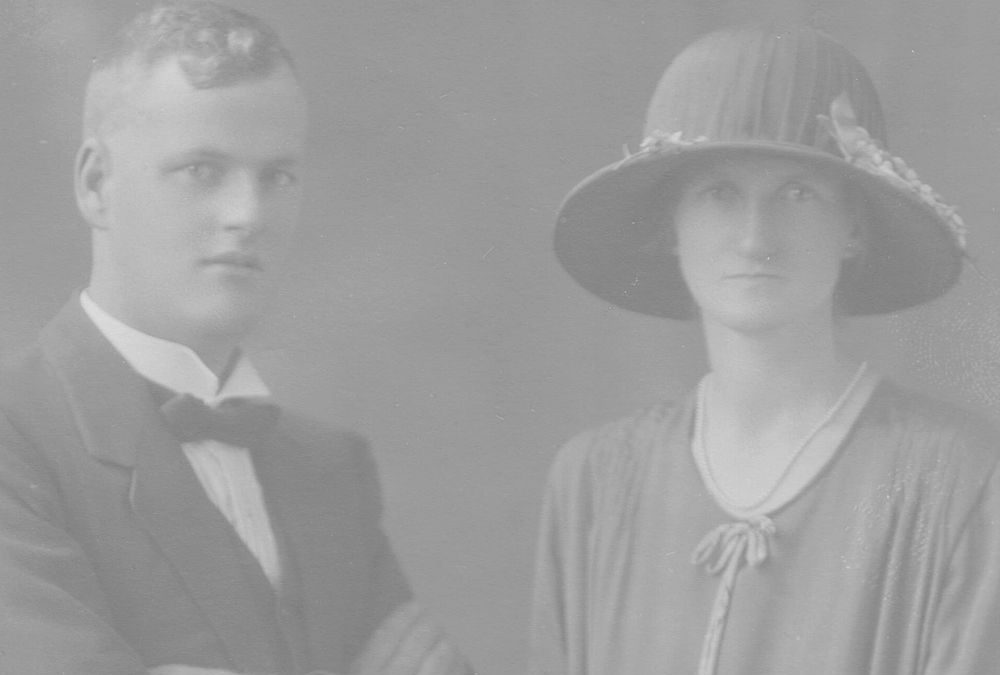Boolburra is the central point of a once-thriving community on the banks of the Dawson River about 100km (60 miles) west of Rockhampton, Queensland.
In the 1870s when the town plan was laid out and the school opened, those who lived in the community saw a prosperous future. But the harsher elements of nature and other forces were to play a significant role for which those early settlers did not account.
The central characters are Alex and Bella Dobbs (pictured above on their wedding day in 1925), their four children and families as well as various other family members and neighbours with whom the Dobbses formed lifelong friendships.
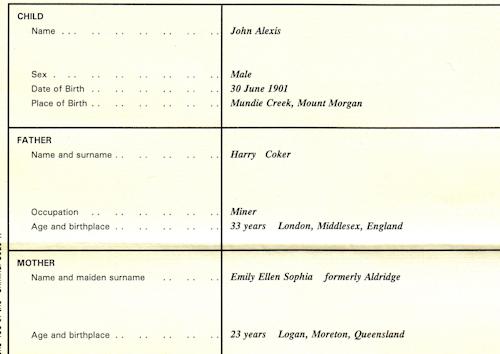
John Alexis Dobbs Coker birth certificate.
The story really starts with a bit of a riddle: who is John Coker? Well, John Coker is Alex Dobbs, or Pop, as both family and friends alike fondly knew him.
His story starts when twin boys were born to Henry Coker and Emily Ellen Sophia Aldridge in Mt Morgan on 30 June 1901.
Harry and Emma, as they were known, already had a 12-month-old son, Walter Frederick (known as Fred).
In the trauma of giving birth to the twins (John Alexis and Edward Henry), Emma became dangerously ill as did baby Edward. Emma’s older sister, Elizabeth Dobbs (nee Aldridge) took care of John Alexis while Emma was in hospital for several months.
Both twins battled to survive those early weeks of life but Edward died at six months. Emma survived the complications of the birth including blood poisoning.
Adoption agreed on
The sisters and their husbands then decided that Elizabeth and Charles would adopt baby Alex as he had so bonded with his aunt.
Four years earlier, Elizabeth had a daughter, Nellie, in a difficult birth that left her unable or unwilling (which of the two is unclear) to have other children.
So Charles and Elizabeth Dobbs adopted John Alexis Coker and his birth was registered as John Alexis Dobbs Coker.
It’s a name he carried until 1944 when he changed it by deed poll to John Alexis Dobbs.
So, young Alex’s mother became his aunt; and his aunt became his mother which, of course, is really confusing. But the Dobbs and Coker families remained close over the years. And while Alex grew up in a two-child family, his natural parents went on to raise his seven siblings.
That was nothing unusual it itself except that Emma Coker was an amazing woman considering she had her right leg amputated as a child.
Mt Morgan connection
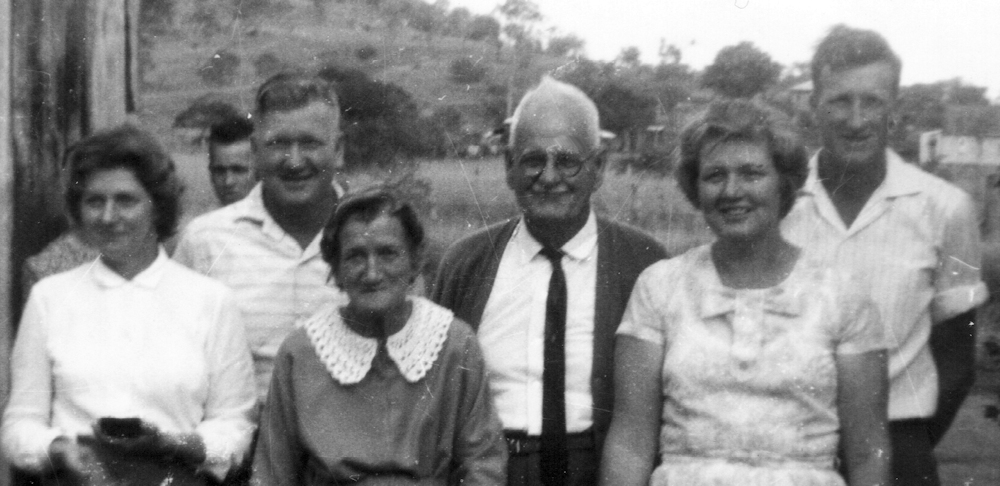
Alex and Bella Dobbs and family at Kabra in 1966 when Pop’s birth mother turned 90.
Both Harry Coker and Charles Dobbs had worked at Mt Morgan mine; the Cokers eventually settled at Kabra a few miles north of Mt Morgan and just west of Rockhampton; while the Dobbses moved to Boolburra around 1917 to take up farming.
At that time, Boolburra was a thriving community with a couple of pubs, school, a dance hall, railway station and even a racetrack.
Charles and young Alex ran a dairy as well as ferrying vehicles across the Dawson River. Nellie then married Ted Goodwin and moved to Bluff, another 50 miles west.
In 1923, Boolburra school welcomed a new teacher, Margaret Isabella Silver, who boarded with Charles and Elizabeth Dobbs.
It proved a life-changing appointment for both Miss Silver and Alex Dobbs.
Time to marry
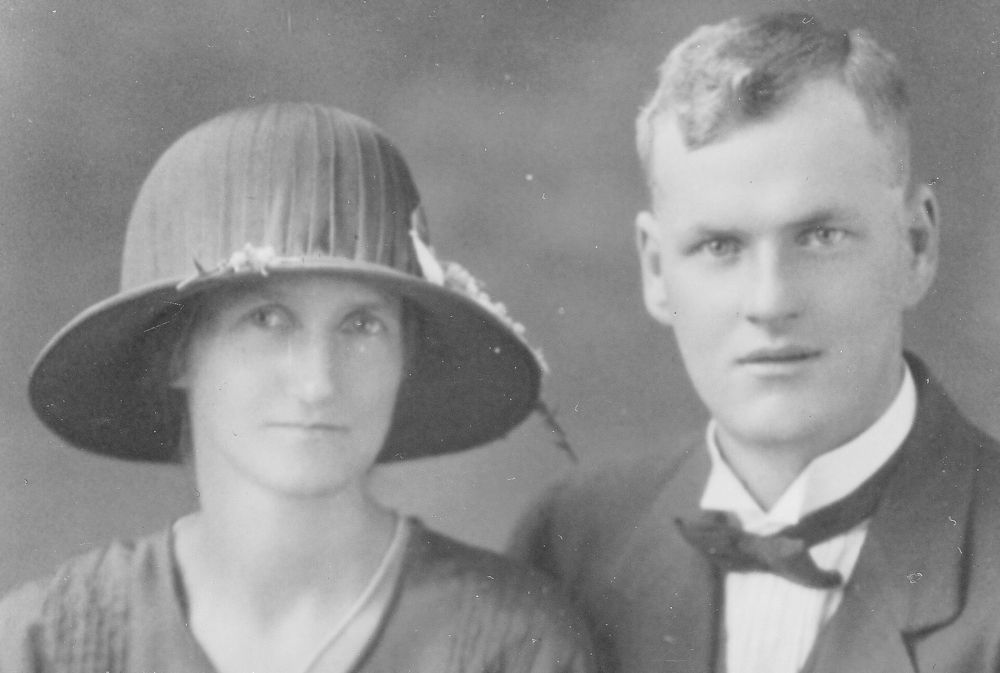
Bella Silver and Alex Dobbs on their wedding day.
Love blossomed and in September 1925, Bella and Alex married at Valley Presbyterian Church in Brisbane. She was 32, Alex just 24 and apparently their marriage did not entirely win the approval of Bella’s parents, James and Janet Silver.
Nevertheless, Alex and Bella set up a business and home in Brisbane.
But The Depression intervened and they eventually had to walk away from their little shop that sold “everything from needles to milk”.
Alex went back to Boolburra to work with his parents while Bella and new-born Mavis stayed with the Silvers in Taringa.
When he got enough money together, Alex sent for his family and there began another chapter in the lives of the Dobbses of Boolburra.
During the 1930s, Charles Dobbs bought another 157 acres of land. On February 3, 1939 he bought for £275 “the leasehold property of the vendor described as Prickly Pear Selection Number 6628 Rockhampton District being Portion 33 County of Pakington Parish of Boolburra containing 1067 acres and sixteen perches more or less”.
It was bought from a James Whitney O’Rourke. (This is the area known as the Tablelands).
A letter from Daniel P. Carey Solicitor, Central Chambers, East Street, dated Oct 7, 1936 to J. A. Dobbs reads:
“Your letter of the 5th instant to hand and contents noted for which I thank you. As requested I enclose herewith Deed of Grant No. C1451 Volume 61 Folio 127 County of Pakington Parish of Boolburra, being portion 24V containing 1 acre.”
While Alex and Bella set up home at Boolburra itself, Charles and Elizabeth moved “down the road” a couple of miles to Avondale Farm, the name the previous owners the Cagneys had given the area.
Converted church
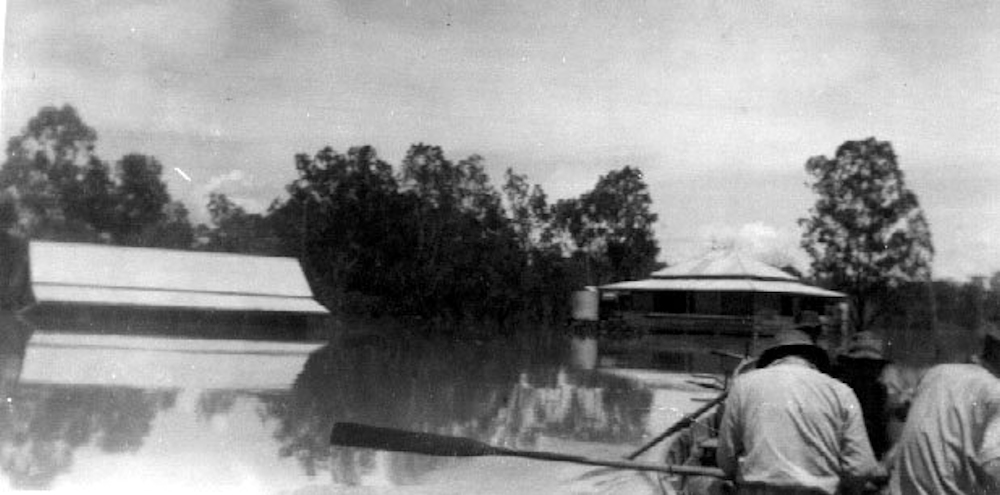
Boolburra during 1954 flood. Cross house at left and Dobbs home.
Alex and Bella had bought and converted a disused Catholic church building as their home; it was known as Braemar, presumably because that’s where her father’s mother was born in Scotland near Braemar Castle.
Verandahs were added over the years and the area underneath built in.
The family grew with the arrival of Ray in 1929, June in 1931 and Jim in 1936. By that time, the school had long closed and Bella home educated the Dobbs children – when they could be persuaded to sit and learn.
Life revolved around farm life and many pleasurable outings to the river with family and friends. A tennis court added to the pursuits of a family that managed life comfortably despite what some might today see as deprivations; no television, fast cars, computers, electricity and other time-saving devices such as we find in modern homes.
Many of we grandchildren still remember in the 1960s when grandma still used an iron warmed on the wood stove to press clothes and when Pop or Jim had to walk down to the milking shed to start the motor that delivered electricity to the house.
For us it was an adventurous world with so much freedom and seemingly endless things to do.
Some tall tales
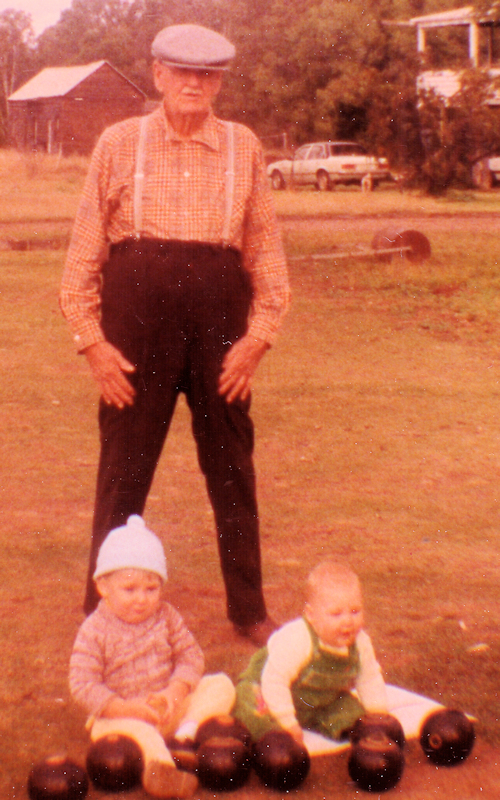
Alex Dobbs in 1985 with great grandsons Daniel and Kayne Kajewski.
Pop seemed to be eternally cheerful, Grandma was always fussing over everyone and Jim was more like a favourite big brother who told us stories about the “bunyips” and “yuengies” in the bush that we had to watch out for after dark.
It did not scare us but rather gave us a wide-eyed respect for our uncle that he was not afraid of such things. It did not cross our minds that he was pulling our leg. It was always a treat to tag along with Pop on visits to neighbours.
It was privilege to be old enough to help out on the exchange and post office which grandma ran. Sometimes there was a mad scramble to get the mailbag together so it could be handed over when the train stopped.
For the Nunn children there would sometimes be the bonus of seeing grandfather George Nunn driving the train.
In later years, a highlight was to go on the mail run with Pop. There was a stop in Duaringa, morning tea along the way and lunch with Mrs Grace at the end of the run was always a pleasure.
Pop loved to stay on for a good yarn and was legend at not sticking to a schedule.
On trips from Rockhampton, Pop regularly stopped at Kabra to see his sister, Edna.
He was also close to another brother, Archie, and often played bowls with his eldest brother, Fred. Pop and Fred did look alike but as their name tags had different surnames, few people knew of the connection; and they liked to have fun with it as well.
Pop mostly kept in touch with his siblings even though they were raised in separate families.
As well as the dairy, Pop kept pigs. In 1953, he bought for £32 11s 0d two Berkshire boars from Berkshire Oakholme Stud, at Ridgelands, near Rockhampton.
Both Charles and Alex showed Jersey cattle at Rockhampton Agricultural Show and won some prizes; mostly for the cows.
Great affection
Alex naturally held a great affection for Charles and Elizabeth and sometimes spoke of the debt of gratitude he felt towards them.
It must have been a little confusing to grow up to know that your natural parents had chosen _ in unusual circumstances _ to allow close relatives to raise their child.
Charles Dobbs died in 1944 and Elizabeth passed on in 1952. They are buried together at North Rockhampton Cemetery.
In 1963, Alex first won a tender for Mail Service 903 Duaringa-Don River that he was to run until 1985 when Jim took over until 1995. One of the early contracts was £325 3s 8d a year.
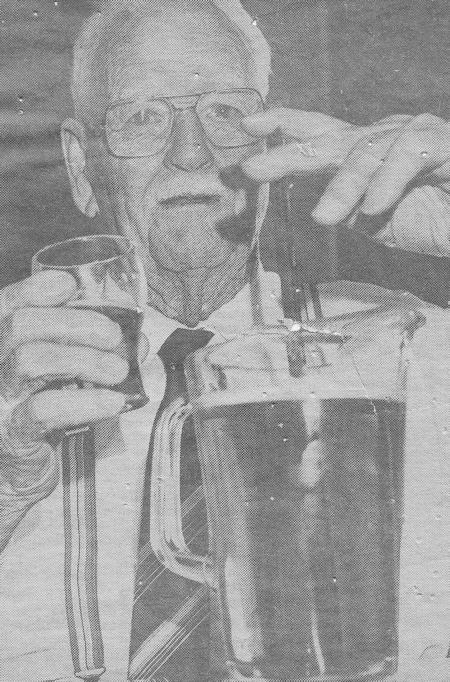
Alex Dobbs in 1986 when the Queensland Water Resources Commission acknowledged the 60 years he made rainfall and river height levels at Boolburra.
Another task at Boolburra was keeping both a record of the rainfall as well as checking the river level. Charles Dobbs first took gauge readings in 1926: Alex and Jim continued until 1986 when the Queensland Water Resources Commission decided to close gauging station No 130301.
A letter from the commission says in part:
“On behalf of the Commission I wish to extend to you and your family my appreciation for the assistance which has been given in the Commission’s Water Assessment Program over the past 60 years. Enclosed is a final cheque for $100 which concluded your Honorarium for gauge reading to 31st December, 1986.”
Flood times
The Dawson River and Herbert Creek provided both life-giving and life-threatening water for the family. Because the house sits on the banks of Herbert Creek that runs into the Dawson River less than a mile away, flooding was an accepted part of life.
The Dawson drains a vast area of Queensland starting near Injune about 250 miles (400km) west of Maryborough. It joins the MacKenzie River only a few miles from Boolburra and becomes the Fitzroy, which runs through Rockhampton to the Pacific Ocean.
Because the tropical rain depressions that cause flooding come mostly from the north, water from the MacKenzie beats any from the Dawson to their juncture. The water backs up and spreads over thousands of acres. Boolburra is in the path of that.
There are numerous photos of the 1954 flood as well as some from 1933. The biggest on record was in 1918.
Rob Silver recalls
In researching Bella’s family, the Silvers, Robert Silver, her brother Jack’s son, wrote fondly of his visits to Boolburra:
“Bell and Alex ran the local post office and telephone exchange and so became the hub of the district. Alex later on ran the mail run to outlying properties. His adopted parents Charles and Elizabeth lived on the property in a house built of slab timber. It was quite a common occurrence, when dining at their huge table, to see two rather large carpet snakes coiled round the exposed beams above your head. These were almost part of the house, as they kept any rats or mice in check.
One room of the old home, was once the local store. One Christmas, when our family was up there on our regular holiday visit, we kids had a ball digging in the dirt under the old store finding old coins which had fallen through the slab floor over the years. The old home had been pulled down, as Charles and Elizabeth had moved to “Avondale”, some distance away.
Next door to the old home was the ‘”Old Hall, which again was a slab structure, and was for many years the social hub of the district. Sadly over the years the population declined until only the Dobbs family remained. The hall became one large storeroom.
Boolburra was the regular Xmas holiday spot for our family. We kids reckoned the dirt, soot, and long steam train journey (no electric trains in those days) and eyes full of cinders when you poked your head out of the window (no air-conditioning), face and clothes black with soot, was all part of the fun to us city kids, because we were bound for the farm on holidays.
Little we cared about the prickles in the yard, we soon learnt to dodge them until our feet toughened up a little. The sandflies were quite a different problem, and those mosquitoes that rose in great black clouds from that Pepperina Tree, they could really bite. Our cure for these was to carry a smoky old cow-dung fire around with us, a smelly, but very effective repellant for the pests.
The home at Boolburra was initially a church, which had been raised and built in underneath. Access to the upstairs bedrooms was by outside stairways, and many was the night we kids slept on mail bags on the earth floor in the kitchen, as it was too wet to go outside to go up to bed.
Auntie Bell usually brewed up a batch of homemade ginger beer at Christmas and used to store it under a long form in the kitchen. One night during a particularly vicious storm, for some reason these bottles started to explode and cause a hasty evacuation of the kitchen. After the storm we would all rush out to see what trees had been blown down.
Here at the farm were things that we city kids never knew. When the morning train (the 10 up as they called it) blew its whistle down the track, we all raced for the station. While the engine took on water, the empty cream cans and any other freight was unloaded, and the Mail Bag was collected from the guard of the train.
After the train had gone, the old place really came alive. The district farmers all came in with their full cans of cream, collect their empty cans, and to receive and post their mail. The mail then had to be postmarked, sorted and the bag sealed ready for the train (the 49 down). Many a day the cry went up, “She’s on the Bridge”, and then there was a mad rush to get the mailbag ready.
Boolburra was a watering station for the old steam locos, and many an hour was spent watching Tom and Jim Cross operating the pump down by the river, to fill the water tanks up at the station.
The road past the farm, was the only road out, and crossed the Dawson River just down the road. Once the water level at the crossing reached 18 inches (45cms), Uncle Alex had to winch them across on an old wagon which he had modified and installed for that purpose. At ten shillings a car he had many complaints, but it was hard work, and he deserved every penny of it. The passenger train to Longreach two nights a week was a highlight for us kids. All those bare feet sticking out of the windows were a temptation for us youngsters to tickle with a small stick. (our country cousins taught us that).
We all belong
It is easy to look back nostalgically at life on the farm but the reality was that it was a good portion of tough times mixed in with the prosperous seasons.
The Dobbs children grew and three of them moved on to raise their families while the youngest, Jim, remained at Boolburra. It is both joyful and sad to look back on the times the families shared at Boolburra.
But times change; Bella died aged 74 in 1968 and Alex at 86 in 1987. None of us who spent time at Boolburra can shake the feeling of belonging, that special connection which words can not adequately describe.
Whatever the future holds, our lives have been enriched by that link with Alex and Bella whether we count them as parents, grandparents, family or friends.
Warren Nunn, son of June Nunn (nee Dobbs)


